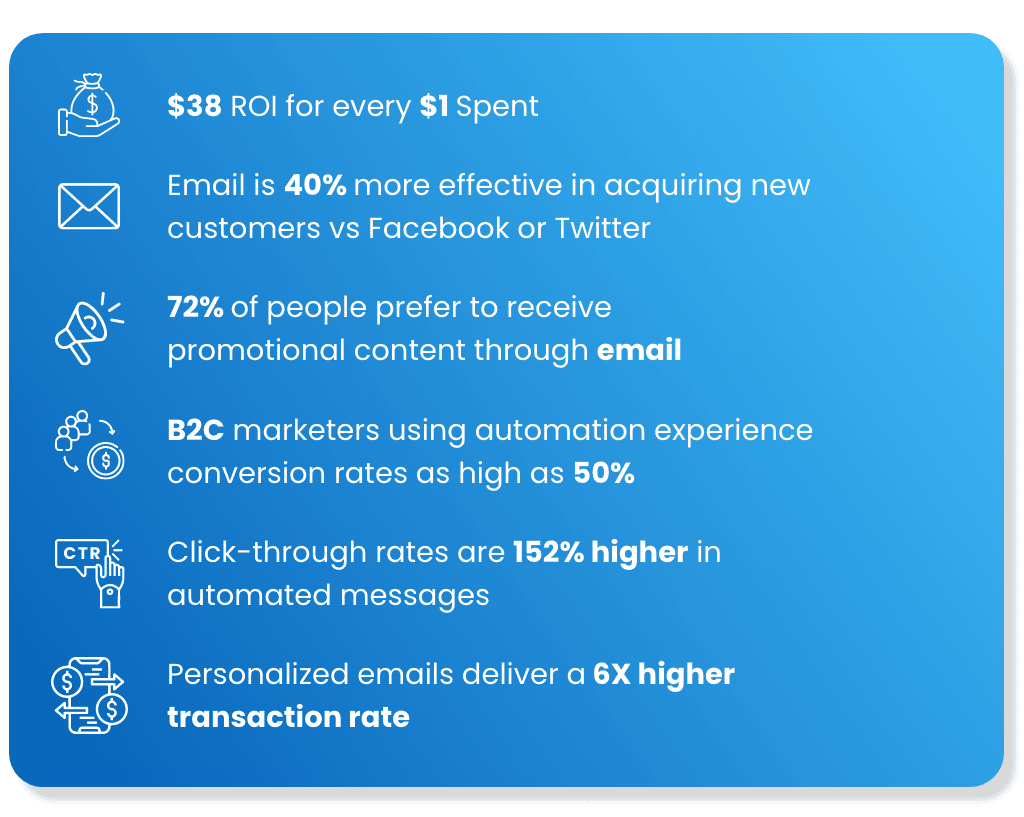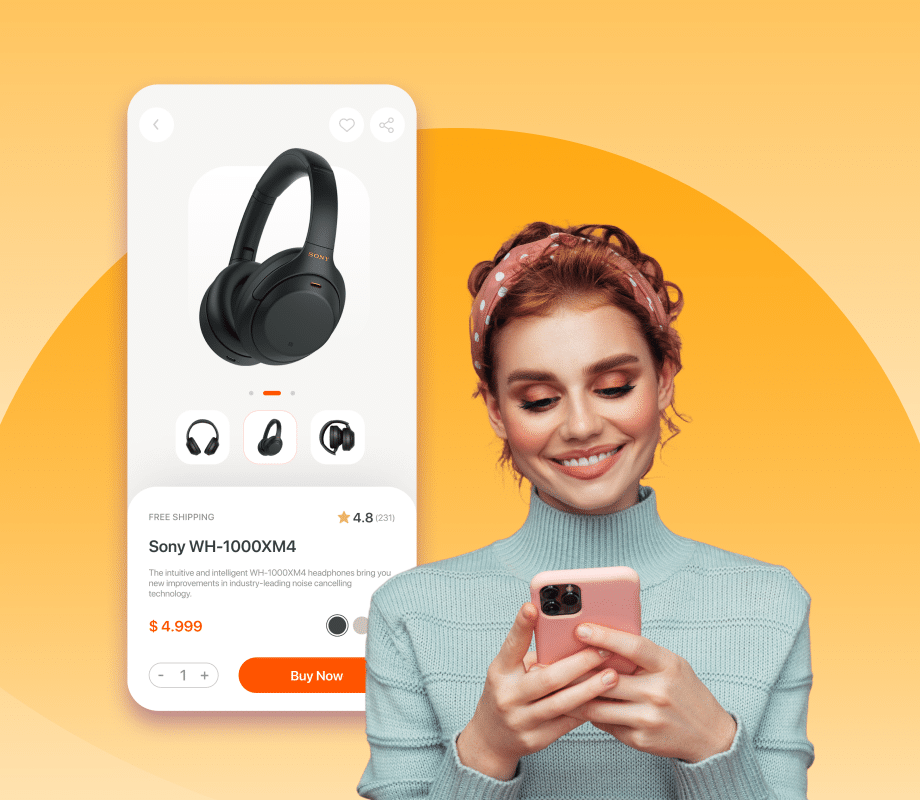So, you put in the work, try to optimize where you see opportunity, and leverage new techniques. You’re excited about this email. Yet, you don’t see the results you were expecting.
It’s frustrating.
In today’s social-media driven world where everything is quick and easy, it is forgivable to assume that email marketing is past its glory days. Yet, this couldn’t be further from the truth.
Marketers still vouch for email to deliver results and here’s why:

But the question remains – how do you improve your email marketing campaigns? Where do you start and how do you go about it?
In this blog, we will cover how you can make the most of your email channel and the best practices in deliverability, personalization, and dynamic content.
Let’s dive right in.
When is the last time you saw an email that resonated with you? One that had you hooked right from the get-go. One that covertly but seamlessly navigated you to click on the CTA button. The brilliance of a well-crafted email that leads to conversions is its simplicity in encouraging action.
While there is no definitive formula to craft the perfect email, here are a couple of pointers to help get you started:
• Focus on Your Key Objective For The Email: While it’s tempting to cram in as many ideas and offers in one email, it is important to hone in on one objective. This is the theme of your email around which everything else falls in place. Imagine crafting an email centered on trying a new holiday theme recipe. However, the email also includes content about passes to a concert. Confusing, right? Always begin with a clear objective. Your content and design must speak to this objective.
• Maintain a 60% Text to 40% Image Ratio: It’s important to structure your email in a way that appeals to the reader. No one has the time to read chunks of text in an email. It is off-putting and can result in a dip in your KPIs. Conversely, an email laden with images can come across as too promotional. Maintain a healthy balance of text and image that conveys a message than a sell.
• Keep Your Subject Line Short And to The Point: Your subject line should not exceed 41 characters or 8 words. This is the first interaction your audience will have with your email – if it doesn’t convey the message on the first read, the reader will most likely ignore the email.
• Your Subject line, Content, And Visuals Need to be Aligned: Imagine a subject line that speaks of an exclusive summer offer, but the banner contains winter cues, while the main content holds information about an upcoming launch. It is haphazard. It will not translate. Nor will it meet its objective for the campaign. The messaging right from the subject line to the CTA must all be aligned.
• Include a CTA in Every 3rd Fold of The Email: This draws attention back to your objective and keeps the reader engaged. This also aids in improving the conversion rate of the email.
• Ensure Your Email is Responsive And Within the Recommended File Size: Bear in mind that your audience accesses and views your email on different devices. With over 60% of emails being opened on mobile devices, it is important to ensure that they are responsive and load with ease. The recommended file size is 80-100 kb.
• Use Valid Links With UTM Tags: Ensure that the links used in your emails contain no typos or errors. It is especially important when your CTA links to a different landing page or sign-up sheet. An error in your link may cost you conversions. Remember to add UTM tags in your emails to track its progress across online platforms. Data is key – gather, analyze, and optimize to make the most of your email channel.
While the guidelines above will help you speak your message to your audience, it is also important to speak to your audience.
Here are three key factors to help you clinch gold in your email marketing efforts:
• Experiment With Personalization: Gone are the days when a cookie-cutter mass mailer did the trick. Your audience wants you to speak to them on a personal level. They want to form a bond with your brand. It is this connection that will drive engagement. Here is how you can experiment with personalization:
1. Lifecycle Email Campaigns – Based on the different life stages in your audience’s journey, create and share emails relevant to each segment. For example, share a welcome email as soon as someone subscribes to your newsletter. Or share an email reminding them about their cart. It is important to cultivate your relationship with your audience at each stage. Sharing emails at each nodule engages them and helps to motivate them along their lifecycle.
2. Always-on Campaigns – Share emails to your subscriber list based on their individual loyalty points accrued, offers based on past purchases, as well as festive offers to help keep them engaged with your brand.
• Drive engagement With Dynamic Content: The more relevant an email is to your audience, the more value you add to your campaign. Dynamic content empowers you to offer your audience a personalized experience at scale. The dynamic content you can leverage to increase the effectiveness of your campaign are:
1. Text – It is the most common and effective type of dynamic content facilitating personalization. You can personalize a line, a sentence, or even a paragraph to different subscribers. For instance, if you are a clothing brand, based on past purchases, you can create a dynamic paragraph on clothing and footwear that can be personalized for each audience segment.
2. Visual – You can change the image, GIFs, and videos based on the segments you target. You can also experiment with various visual elements based on your segment.
3. CTA – You can customize the size, shape, color, and text within your call to action to drive your click-through rate and result in conversions.
4. Offer – Include customer offers in your email campaigns based on seasonality, gender, interests, available inventory, timing, and other personalization variables. For instance, let’s assume you run an email campaign with an offer for shoes at a discounted price. Say this email resonated with the people from Japan (in the JST time zone) and they made use of the discounted price. Consequently this resulted in you running low on stock. The people in the Pacific Time zone have yet to view this email. This gives you a leeway to switch the offer with a discount on another product. So, when a person from the PST time zone views the email, they will see the new offer.
• Analyze And Enhance Deliverability: With elements of the email now in place, it’s time to dot your ‘i’s and cross your ‘t’s. Deliverability does have an impact on the performance of your email campaign. Here’s how you can avoid dips in your performance owing to low deliverability:
1. Authenticate – Ensure that your SPF, DKIM, and DMARC records are in place. This will help internet service providers verify that your mail server is authorized to share mass emails.
2. Monitor – Routinely check if your brand or sender ID figures on any blacklists. Review your brand’s score in senderscore (you want to fall in the 90-100 percentile), and errors in postmasters, to ensure that you are clear of any shortcomings. This will help ensure that your emails go out without a hitch.
3. Act – It is important to monitor and make changes as your campaigns progress. When you notice a spike in the number of unsubscribes, it is wise to reduce the frequency of emails being sent. This helps to sustain your sender reputation until you can adopt a different strategy. Routinely purge the ID with bounces and non-openers that show up after 180 days. This will help you maintain a healthy list and in turn healthy email campaign performance.
In summary, email continues to remain a robust and effective digital marketing tool. When executed the right way, a successful email marketing campaign can lead to a great customer experience and higher sales. The vast opportunities available with email give you the ability to experiment and improve as you go. Don’t be afraid to get creative with your emails (emojis add flair too!). In closing, always remember to adapt, test, and optimize!
Learn more on how Algonomy can help you create a winning email marketing campaign.
 in Sweden from 7 - 8 October 2025. Pre-book a meeting to connect with our
product experts.
in Sweden from 7 - 8 October 2025. Pre-book a meeting to connect with our
product experts.










